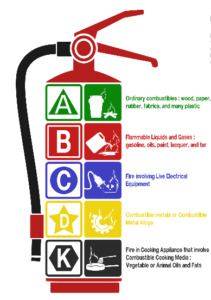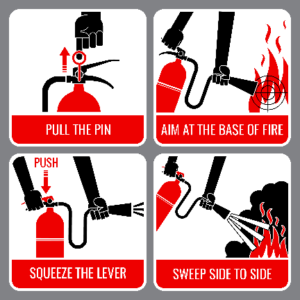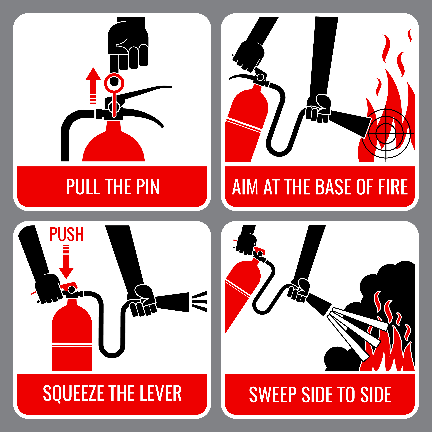We should all have at least one fire extinguisher somewhere in our home, but it’s not enough to simply keep one under the kitchen sink. If there is a fire, your safety—and the safety of your home—depends on knowing how to properly use that fire extinguisher. As your insurance agent, we strongly urge you to read and follow the following safety prevention tips to keep you, friends, and family safe. There’s no excuse not to!
In case your fire extinguisher has been sitting around collecting dust, here’s everything you need to know before brushing it off and fighting a fire in your home the right way.
Choose the right fire extinguisher.
The first thing you need to know is the different classifications of fires, and the second thing you need to understand is what types of fires you may have to deal with and make sure your extinguisher can get the job done. Most household fires fall into one of the following categories:
Class A: These fires are fueled by solid combustibles like wood, paper, and cloth.
Class B: These fires are fueled by flammable liquids such as oil, petroleum, and gasoline.
Class C: These fires are started or fueled by faulty wiring, fuse boxes, and appliances.
Class K: These fires are started or fueled by cooking oils and greases, animal fats, and vegetable fats.
Please watch this video on how to correctly operate and use a fire extinguisher from CQ Fire & Safety.
All fire extinguishers are labeled to indicate which classes of fire they are designed to combat. Most household fire extinguishers are considered multipurpose and labeled for use in A, B, and C classes. Fire extinguishers safe for Class K fires are heavier duty and will need to be bought separately. Fire extinguisher labels also include symbols to indicate which types of fires the extinguisher is designed to fight. If there is a circle and a red slash through any of the symbols, that indicates that the extinguisher cannot be used to fight that type of fire.
Steps for proper fire extinguisher use
Once you understand the different types of fire extinguishers and their uses, you need to be able to properly operate one.
The best way to be ready for a fire emergency in your home is to study the steps below and review them regularly so you can protect your home and family.
- Identify a clear exit/escape route
Before operating the fire extinguisher, make sure you have a clear evacuation route. If you cannot put out the fire, you’ll need to make a safe exit. Consider this when determining where to store your fire extinguisher, and make sure you’ll have multiple exit options nearby after you retrieve it.
- Stand back
Face the fire and keep your back to the clear exit you earlier identified. You should stay between six and eight feet away from the flames as you prepare to operate the fire extinguisher.
- Discharge extinguisher
It can be difficult to think clearly during an emergency, so fire safety has a long-standing acronym to help you recall the steps involved in operating your fire extinguisher. Just remember PASS:
P: Pull the pin on the fire extinguisher.
A: Aim the nozzle on the hose low, toward the base of the fire.
S: Squeeze the handle or lever to discharge the extinguisher.
S: Sweep the nozzle back and forth. Keep the fire extinguisher aimed at the base of the fire and move it from side to side until the flames are extinguished.
- Keep an eye on things
After the flames appear to be out, continue to watch the fire area to make sure it doesn’t reignite. If the fire does start up again, repeat the PASS process.
- Call the fire department
If you didn’t have the chance to call the fire department before discharging the fire extinguisher, do so now. They will be able to inspect the site of the fire and make sure that it is completely extinguished.
- Get to a safe place
Once the fire is out, or if you are unable to extinguish the fire, leave the scene and find a place out of reach of the fire.
Many people put out small fires quite safely. However, death or serious injury can occur by tackling a fire which is beyond your capabilities. Only tackle a fire in its very early stages and always ensure you put your own and other people’s safety first. If you cannot put out the fire or if the extinguisher becomes empty, evacuate yourself and everyone in the home immediately, closing all doors behind you as you go. If there is the slightest doubt or uncertainty about tackling the fire, evacuate the building immediately and call your local fire department.
The best way to keep your home and family safe in the event of a fire is to be prepared. Get to know your fire extinguishers and regularly review how to properly use them. A little advance practice can make all the difference when you’re faced with the stress of an actual fire in your home. Contact East Douglas Insurance Agency at (508) 476-2101 or visit our website https://eastdouglasinsurance.com/personal/ to discuss your current home insurance needs. We are happy to provide coverage from many insurance carriers so you receive the insurance for your budget and needs.
Source: https://www.safewise.com/blog/prepared-properly-use-fire-extinguisher/ and https://www.marsden-fire-safety.co.uk/resources/fire-extinguishers/using-a-fire-extinguisher

